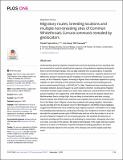Migratory routes, breeding locations and multiple non-breeding sites of Common Whitethroats Curruca communis revealed by geolocators
Date
01/09/2022Metadata
Show full item recordAbstract
Understanding general migration characteristics and how breeding and non-breeding sites are connected is crucial for predicting the response of long-distance migratory bird populations to environmental changes. We use data collected from six geolocators to describe migratory routes and identify breeding and non-breeding locations, migratory behaviour and differences between spring and autumn migration of Common Whitethroats Curruca communis, an Afro-Palearctic migrant, wintering in Nigeria. Most individuals departed on spring migration in April, following a north-easterly direction, arriving at their breeding grounds across central-eastern Europe (~425,000 km2) in May. Departures from breeding grounds took place between July and August in a south-westerly direction. During spring migration individuals travelled longer distances at faster rates making its overall duration shorter than autumn migration. We suggest that, while Whitethroats can cross the Sahara Desert and Mediterranean Sea in a single flight, they are likely to refuel before and after crossing. Results indicate that Whitethroats undertook loop migration and visited two wintering sites: first in the Sahel, then in Nigeria, where they remained until spring migration. Geolocator results and data from the European Union for Bird Migration’s (EURING) ringing database suggest that Whitethroats have a relatively high migratory spread—individuals from a single non-breeding site breed across a wide area of Europe. Our research is the first to track and describe the complete annual cycle of Whitethroats and one of the few studies to do so for any Afro-Palearctic migrant from non-breeding grounds. We identified the Sahel as an important refuelling and first wintering site indicating its conservation, alongside other stopover sites, is crucial for the species. We believe that changes in this region will have severe effects on a subset of individuals of specific European breeding populations, but these effects will greatly depend on the severity of the changes and at what spatial scale they occur.
Citation
Tapia-Harris , C , Izang , A & Cresswell , W 2022 , ' Migratory routes, breeding locations and multiple non-breeding sites of Common Whitethroats Curruca communis revealed by geolocators ' , PLoS ONE , vol. 17 , no. 9 , e0274017 . https://doi.org/10.1371/journal.pone.0274017
Publication
PLoS ONE
Status
Peer reviewed
ISSN
1932-6203Type
Journal article
Description
Funding: This work was supported by the National Council for Science and Technology (CONACyT, Mexico, https://conacyt.mx) through scholarship number 472286 to CTH, and the AP Leventis Conservation Foundation (https://www.leventisfoundation.org/).Collections
Items in the St Andrews Research Repository are protected by copyright, with all rights reserved, unless otherwise indicated.

